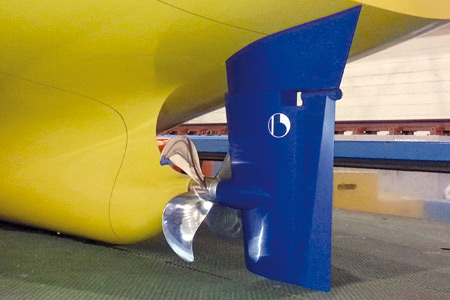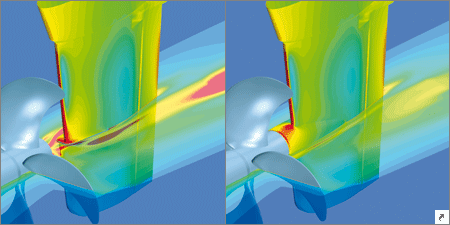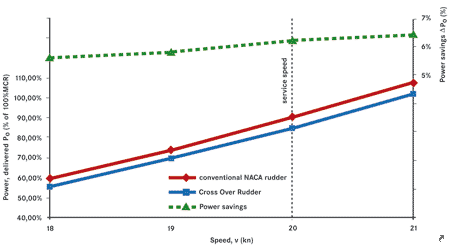
The new generation of efficient merchant vessel requires high standards of manoeuvring and propulsion efficiency. The new Cross Over Rudder design unites Becker Marine Systems’ expertise in rudder design and new propulsion efficiency technologies by introducing a new type of rudder featuring a rudder bulb and fairing cap.
Main benefits of the new Cross Over Rudder:
- The new FEHC Flow Efficient Hub Cap
- An optimised rudder bulb with no loss of manoeuvrability
- Fuel savings of up to 7% due to efficient rudder design
- Improved course keeping
- No propeller hub cavitation
- Available for newbuildings and retrofits
- Designed for feeder vessels and ferries
- Optional trailing edge flap available
Using the experience of aft ship optimisation with energy-saving devices and flow-optimised rudders, Becker is introducing the Cross Over Rudder as an improved propeller/rudder solution, including a new fairing hub cap (Flow Efficient Hub Cap or FEHC) and a new rudder bulb design with no loss of manoeuvrability.
The FEHC and the rudder bulb reduce fuel consumption by up to 3% and prevent propeller hub cavitation. The design was optimised by our R&D department for swirled propeller flow using Computational Fluid Dynamics (CFD). Cap and bulb can be designed independently from the propeller manufacturer, which makes the Cross Over Rudder available for retrofits as well as newbuildings.

CFD simulation of energy losses in the water flow without (left) & with (right) rudder bulb.
The new rudder employs the Becker KSR support, which allows for slender rudder shapes due to the smaller stock diameter. This in-house knowledge enables Becker alone to design thin and high-lift rudders with little drag. In addition to the standard Cross Over design, the rudder can be provided a trailing edge flap. The flap rudder design ensures a high degree of manoeuvrability and improved turning ability suitable for vessels such as feeder ships or ferries in transient and harbour operations. The Cross Over Rudder requires only small rudder angles to keep the vessel on course when in transient, leaving the rudder bulb in the shadow of the fairing cap wake.
Extensive CFD studies and model tests have improved the performance of this type of rudder by 150% over conventional rudders. Together with the twisted leading edge for fast vessels, the rudder’s drag can be decreased to reduce fuel consumption by another 4%. The new propulsion-optimised twisted rudder profile is aligned with the propeller’s slipstream and prevents rudder sheet cavitation at rudder angles of up to 10°. The twisted leading edge increases the rudder’s endurance and service requirements while docking time is lowered, providing additional savings in the long term.

Model test results with a 180 m car ferry at Hamburg model basin, HSVA.
To get the best performance from the new rudder, Becker is offering its Becker Intelligent Monitoring System (BIMS) and the new (optional) Becker Bearing Monitoring System (BBMS). The systems monitor rudder force and drag and measure wear on the high-stressed neck bearing without having to dismount the rudder.
All in all, Becker’s Cross Over Rudder can improve propulsion efficiency of well-customised ship lines by up to 7% and increase manoeuvrability and independence from harbour support services tugs at the smallest of harbours and along difficult coastal areas for vessels such as feeder ships and ferries.
|